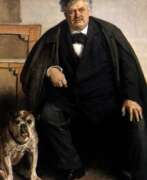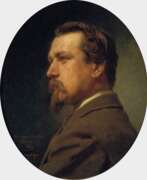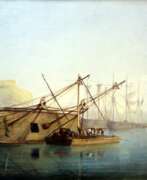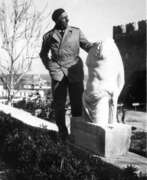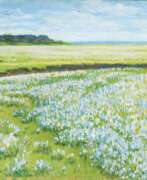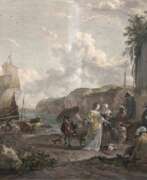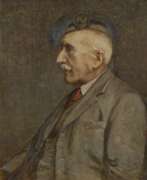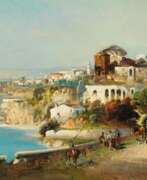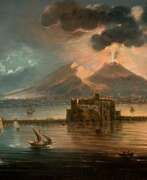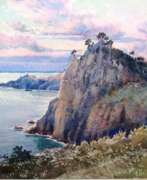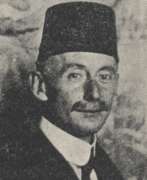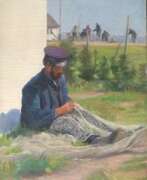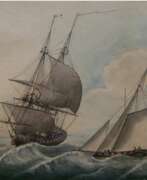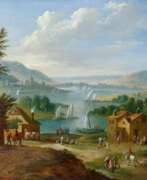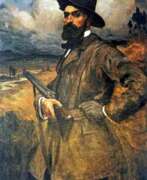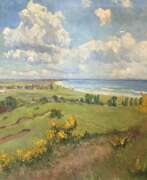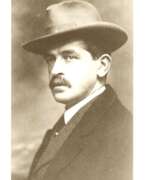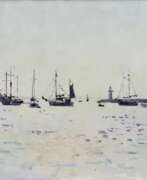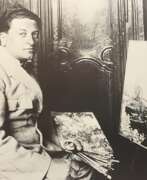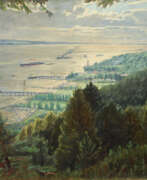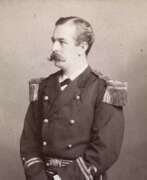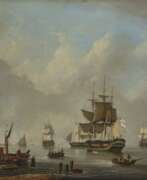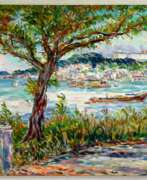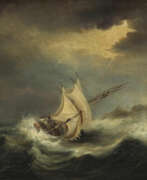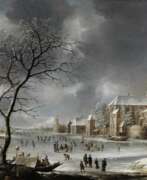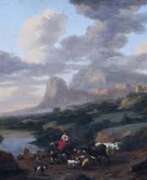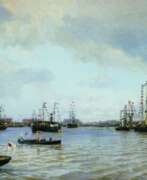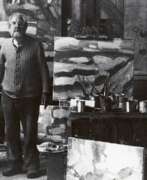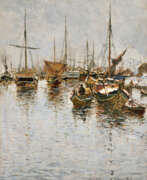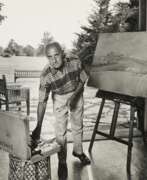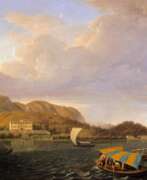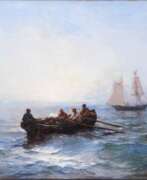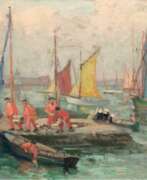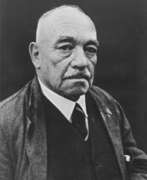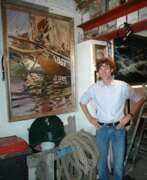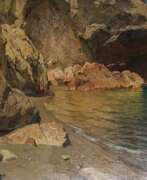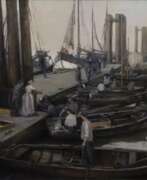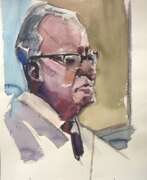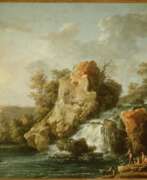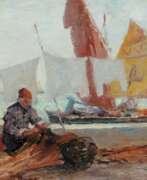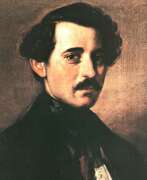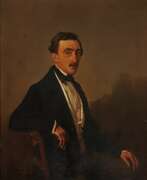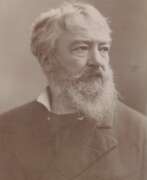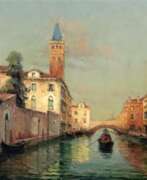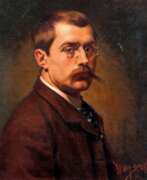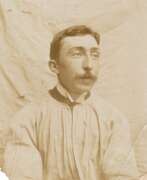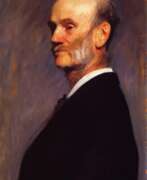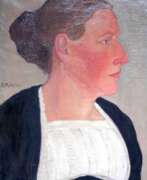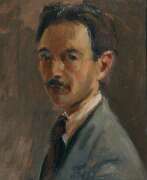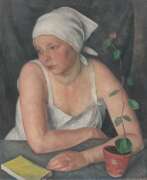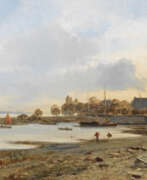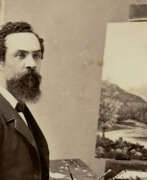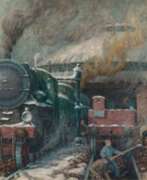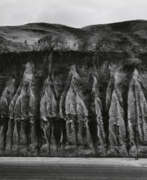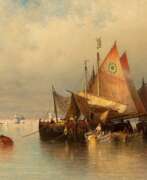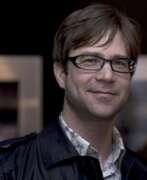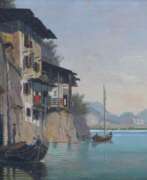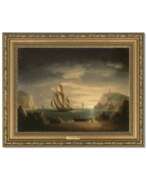Marine art
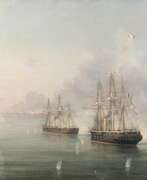

Antonio De Simone was an Italian marine painter.
He created many paintings depicting various ships at sea: frigates, yachts, sailing ships and steamships, in the storm and with the sails down. De Simone also painted historical battle scenes, such as his famous painting - "Bombardment of Alexandria", which is in the Royal Greenwich Museums.
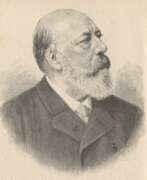

Andreas Achenbach was a German landscape and seascape painter in the Romantic style. He is considered to be one of the founders of the Düsseldorf School.[citation needed] His brother, Oswald, was also a well known landscape painter. Together, based on their initials, they were known as the "Alpha and Omega" of landscape painters.


Otto Ackermann was a 19th-century German painter, mainly of landscapes. In 1897, he moved to Düsseldorf, where he remained until his death. He painted mainly landscape paintings of Belgium and the Netherlands, also working in printmaking on the same subjects. He was chairman of the local Düsseldorf Painters' Society and is mentioned in the diaries of Albert Herzfeld.
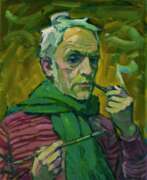

Heinrich Emil Adametz was a German expressionist painter.
Adametz studied in Hamburg and at the Academy of Fine Arts in Stuttgart. Influenced by Expressionism, he painted portraits, seascapes with ships, and still lifes. Later, the events of World War II took such a heavy toll on the artist's family that he was unable to recover from them for the rest of his life.
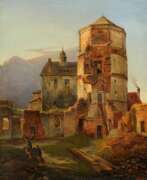

Carl Adloff was a German landscape painter. He is known for his urban scenes, architectural compositions and winter views.
Carl Adloff studied painting at the Düsseldorf Academy of Fine Arts from 1833 to 1843, where he attended the landscape class of Johann Wilhelm Schirmer and the architecture class of Rudolf Wigman. His choice of motifs favoured the Dutch landscape, based on seventeenth-century Netherlandish painting. He often painted seascapes enveloped in a romantic mood of tranquillity in moonlight, morning and evening light.
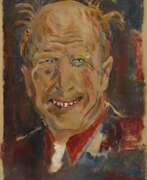

Lucien Adrion was a French post-impressionist painter, draughtsman and printmaker. He is known for his depictions of the French countryside and beaches, as well as of Parisian life, including landscapes, still lifes, figures and landmarks.
Throughout his career, Adrion exhibited his work at the Salons in Paris, where he was praised for his ability to capture the movement and transience of city life.


Ivan Konstantinovich Aivazovsky (Russian: Иван Константинович Айвазовский) was a Russian-Armenian painter, celebrated for his mastery in depicting seascapes. Born in 1817 in Feodosia, Crimea, Aivazovsky became one of the most renowned Russian artists of his time, with a career spanning over 60 years during which he created more than 6,000 paintings. His work is characterized by a profound understanding of the play of light on water, capturing the essence of the sea like no other artist of his era.
Aivazovsky's paintings stand out for their dramatic intensity and the emotional depth they evoke. He was particularly adept at illustrating the sea's many moods, from calm, serene waters to tumultuous storms. His ability to depict light, whether it be the tranquil glow of the moon on the water's surface or the fierce blaze of the sun setting over the ocean, was unparalleled. Among his most celebrated works are "The Ninth Wave" and "Among the Waves," both of which showcase his skill in portraying the sea's power and beauty. These masterpieces can be found in prestigious museums and galleries worldwide, including the State Russian Museum in Saint Petersburg and the Tretyakov Gallery in Moscow.
For collectors and experts in the realms of art and antiques, Aivazovsky's oeuvre represents a pinnacle of romantic landscape painting. His works are not only aesthetically magnificent but also embody a rich cultural and historical narrative, making them highly sought after in the art market. If you are passionate about the fusion of culture, art, and history embodied in painting, Ivan Konstantinovich Aivazovsky's works are a testament to the enduring allure of the sea and its many faces.
To stay informed about new product sales and auction events related to Ivan Konstantinovich Aivazovsky, we invite you to sign up for our updates. This subscription ensures you're always in the know about opportunities to add a piece of this legendary artist's legacy to your collection.
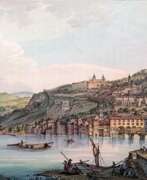

Jean-François Albanis Beaumont was a French landscape painter, engineer, traveler and geographer.
He studied engineering in Paris and worked on architectural structures at Chambérly. Beaumont later accompanied the Duke of Gloucester, William Frederick of Hanover on a grand tour of Germany, Italy, France, and Switzerland, making notes and detailed pictorial sketches of views along the way. In 1800 he published the illustrated books Journey to the Lepontine Alps from France to Italy and Description of the Grecian and Cottian Alps (1802 and 1806).
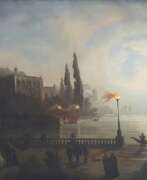

Gustav Adolf Amberger was a German painter and graphic artist. He lived in Rome for two years and learned the painting trade from Peter von Cornelius. One of his first works was the painting The Oceanides. Amberger worked as a designer in the ribbon factory founded by Philipp Trüdinger. Around 1870 he was the court painter to the Landgrave of Hesse. In Antwerp he was a pupil of Joseph van Lerius and made numerous copies, of which Les deux voies is the best known.
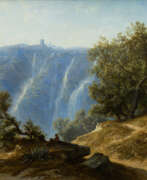

Auguste Anastasi is a French landscape painter of the Barbizon School.
Auguste Anastasi was a student of Paul Delaroche and Jean-Baptiste Corot. He painted landscapes around Paris, Normandy, Holland and Italy, in Rome and especially in Naples, but also in the Tyrol, of which he also made lithographs.
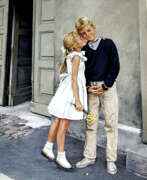

Kurt Ard was a Danish illustrator, painter and printmaker. He became internationally famous for his narrative cover artwork published in popular magazines of the 1950s-1970s, including the Family Journal, the Saturday Evening Post and Reader’s Digest. Ard started his career at various smaller newspapers and worked in the same realistic tradition as his role model, illustrator and painter, Norman Rockwell. During WW II, Kurt struggled to fulfill commission orders. His painting and his reputation and success grew steadily in the post war years. His illustrations soon appeared in major European publications, and he subsequently achieved international fame. Over the course of his career, Ard has sold more than 1000 illustrations to the best magazines in Europe, and to American publications such as McCalls, Good Housekeeping and Redbook. Today, Kurt continues to create exceptional figurative, landscape and seascape paintings with uncompromising authenticity , capturing the charm, beauty and power of these diverse subjects. His work is especially notable for its brilliant light and precise detail.
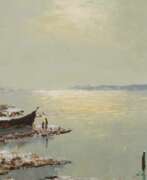

Georg Arnold-Graboné was a painter of German impressionism and an art teacher.
Arnold-Graboné became well known for his unique style of Palette knife painting. His technique used the texture of thickly applied paint to create an actual three-dimensional representation of a landscape. In Graboné's works, the colors are remarkable for their brilliance, distinguishing his landscapes from those of other pallet-knife painters. The brilliance is a result of Graboné's color-separation technique in knife-painting. His favorite subjects were of the Alps of Bavaria and South Tirole, the Isle of Capri, the English Garden in Munich, the lake region surrounding Starnberg, and fishing boats on the North Sea. His unusual signature is incised into the wet paint with the opposite end of the brush, almost invariably on the bottom left hand of his oil paintings (and on the bottom right for watercolors).
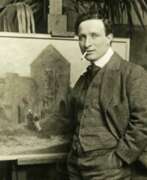

Charles Garabed Atamian is a French artist of Armenian origin born in Turkey.
He studied for a time at the Academy of Fine Arts in Venice, then worked as chief designer at a porcelain factory in Istanbul. In 1894, Atamian worked with a team of artists to decorate the new palace of Sultan Abdul-Hamid Il in Yildiz, on the European side of the Bosphorus. He designed, among other things, the patterns for the ceramic tiles of the palace walls.
In 1897, Atamian emigrated to France and began illustrating books and magazines, as well as working on sets for several Parisian theaters. Since 1903 Atamian participated in various exhibitions with unquestionable success. He painted landscapes, sea and beach scenes with children (including some 200 paintings at Saint-Gilles in the Vendée, where he resided each year during the summer months from 1923 to 1939). Throughout his career he was a fine portrait painter. He became a member of the National Society of Artists in 1927.
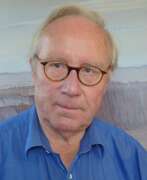

Gerhard Ausborn was a German painter. He studied painting at the Hamburg University of Fine Arts.
Landscapes, ancient sites and modern cities characterise the subject of Gerhard Ausborn's paintings. In parallel, he creates abstract compositions without objects.
The paintings are inspired by impressions the artist gathered during his numerous journeys to many countries around the world. The paintings were not created on location, but always afterwards in his Hamburg studio. They are not intended to be an exact copy of reality, but rather, in memory, what is seen is reduced to the essentials and combined with the artist's own ideas, sensations and experiences.
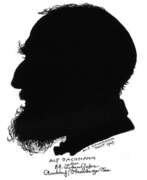

Alfred August Felix Bachmann, a distinguished German Orientalist painter, carved a niche for himself in the realm of art with his exceptional talent. His journey in art began post-high school, under the tutelage of Max Schmidt at the Königsberg Academy of Art, eventually leading him to explore and derive inspiration from various European locales. Bachmann's dedication to his craft saw him making Munich his home from 1891 onwards, immersing himself in the city's vibrant art scene.
Bachmann's oeuvre primarily showcases his profound connection with coastal landscapes, though his versatility also shines through in his depictions of prairies and hilly terrains. His participation in the prestigious exhibitions at the Glaspalast in Munich since 1887 underscores his prominence in the art world. Notably, his artistic excellence was recognized with a gold medal at the Glaspalast exhibition in Berlin in 1913, an Austrian Grand Gold Medal Service Award in 1917, and the German Service Cross in 1952, attesting to his significant contributions to art.
His artistic journey included an intriguing role appointed by Otto Erich Hartleben to the "Halkonian Academy for Unexplored Sciences," where Bachmann created a poignant last portrait of Hartleben, titled "Last Greetings." This work, among others, demonstrates Bachmann's deep intellectual and emotional engagement with his subjects.
Bachmann's legacy is celebrated in many esteemed collections, evidencing the lasting impact of his works on the art community and collectors alike. His contributions to Orientalist painting and his unique ability to capture the essence of his subjects have solidified his place in art history.
For art collectors and enthusiasts keen on exploring the works of Alfred August Felix Bachmann, signing up for updates can enrich your collection with pieces that not only exemplify exquisite craftsmanship but also carry historical significance. Stay informed about new sales and auction events dedicated to Bachmann's art by subscribing for updates today.
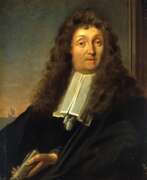

Ludolf Bakhuizen was a Dutch painter of the 17th and early 18th centuries. He is known as an outstanding master of seascapes. Bakhuizen also painted biblical themes and portraits of his contemporaries as well as engravings and miniature models of ships.
Ludolf Bakhuizen is considered one of the best marine painters of the Golden Age of Dutch painting. Among the admirers of his work were many influential European rulers, including the Russian Tsar Peter the Great. The master met Peter I, who visited Amsterdam in the mid-1690s and, according to contemporaries, even managed to give some painting lessons to the Russian tsar. In addition, Вakhuizen made models of all kinds of ship designs on commission from Peter the Great.
Toward the end of his life, the Amsterdam authorities honored Bakhuizen by opening his own gallery on the top floor of the City Hall for his achievements in the fine arts. The best masterpieces of his work are now preserved in museums in the Netherlands, Germany, England, France, and Italy.
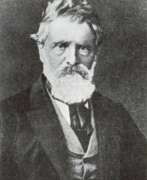

Peder Balke, née Peder Andersen, was a Norwegian landscape painter and marinist.
Balke is one of the most prominent representatives of Romantic painting in Northern Europe. After receiving his art education at the Royal Academy of Art in Stockholm, he made a great journey to the northernmost parts of Norway in 1832, which inspired him for the rest of his life. Throughout this long itinerary, the artist made sketches and sketches that later developed into large canvases. Some of these paintings were bought by the Swedish royal family, some went to the Palace of Versailles and the National Gallery of Oslo. Balke also traveled to Germany and Russia, and visited Paris and London.
Peder Balke mainly depicted Arctic landscapes - snowy cliffs and mountains, midnight sun and northern lights, a sea full of danger with ice. But this wild, pristine and powerful beauty of Norway in the artist's view is full of drama and perhaps in need of protection.
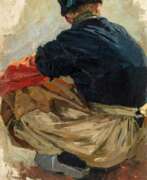

Hans von Bartels was a German painter.
Bartels is associated with the Düsseldorf school of painting. Although an oil painter of great power, he is also one of the leading German water-colour painters, mainly of marines and scenes of fishing life, painted with rude vigour and a great display of technical skill. Bartels made a great contribution to the development of the watercolour. He was the first to use watercolour paint of large formats without the earlier conventions. From 1887 Von Bartels came every summer to the Dutch coast, especially to Katwijk aan Zee, to paint the fisherfolk and their labour. He excels in storm scenes and in depicting the strong, healthy fishing-folk of the northern coasts. He became an honorary member of leading English, German, Dutch, Belgian and Austrian art societies.
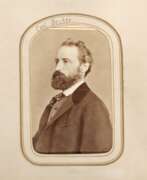

Carl Emil Rudolf Ludwig Becker was a German marine artist.
He was awarded gold medals at the International Art Exhibition of 1894, in Vienna, and the Große Berliner Kunstausstellung of 1896. Three years later, he was one of the co-founders of the Düsseldorfer Künstler-Vereinigung (artists' association). After the turn of the century, marine painting was heavily promoted by Kaiser Wilhelm II, who was attempting to make Germany a major sea power. As a result, the demand for Becker's paintings increased farther inland.
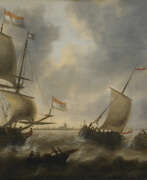

Jacob Adriaensz. Bellevois was a Dutch marine painter.
Bellevois was a follower of Jan Porcellis and Simon de Vlieger and specialized in seascapes. The artist was apparently well acquainted with maritime affairs: his dramatic depictions of various ships in a raging sea and shipwrecks on cliffs are full of characteristic detail.
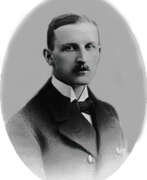

Claus Friedrich Bergen was a German painter of the first half of the twentieth century. He is known as a marine painter and illustrator.
Claus Bergen illustrated Karl May's adventure tales early in his career, creating more than 450 works. He specialized in nautical subjects, depictions of fishing and coastal landscapes, and traveled to Norway, England, the Mediterranean and America. During World War I, Bergen created paintings depicting sea battles; he was the only artist of his time to participate in a submarine raid. In World War II, he was included by the Nazis in the "God-given list" and his work was exhibited in Nazi exhibitions in Munich from 1937 to 1944.
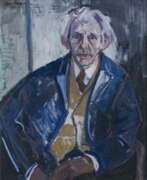

Tom Beyer is a German artist.
Beyer studied at the Düsseldorf School of Applied Arts, traveled throughout Europe, in 1931 opened a studio in Berlin and joined the Communist Party. Although the National Socialists who came to power in Germany in 1937 forbade him to exhibit, from 1939 to 1945 Beyer took part in World War II as a Wehrmacht soldier.
After the war, Beyer led an active social and artistic life. He was also a member of the Association of Visual Artists of the GDR and became its chairman in 1950. As a member of the SED, Beyer reflected in his works the socialist construction in his country, depicting nature and people. He created a large mural for the Löwenschen Saal hall in the Stralsund town hall. From 1972 he taught part-time at the Berlin-Weißensee School of Art.


Sophie Antonie Biel was a German landscape painter and illustrator.
Despite the fact that it was very difficult for women in the mid-19th century to engage in creative work, Antonie Biel created a large number of coastal landscapes of the Baltic and North Seas. She also illustrated novels and was a participant in numerous exhibitions.
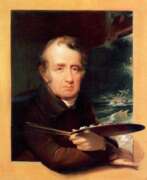

Thomas Birch was an English-born American portrait and marine painter.
He exhibited regularly at the Pennsylvania Academy of the Fine Arts for forty years, beginning in 1811, and managed the museum, 1812-1817. His work is collected at PAFA, the Library Company of Philadelphia, the Philadelphia Museum of Art, the Smithsonian American Art Museum, the U.S. Naval Academy, and the Museum of Fine Arts, Boston, among others. In 1833, he was elected into the National Academy of Design as an Honorary member.
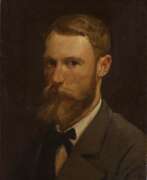

François-Louis David Bocion was a Swiss impressionist painter. He was originally interested in historical subjects, then became a landscape painter and marine painter. He painted some of his famous paintings in Venice, and Bocion gained international fame primarily as the "painter of Lake Geneva.
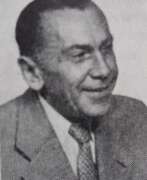

Adolf Konrad Walter Bock was a twentieth-century German painter. He is known as a marine painter.
Adolf Bock, as a sailor in the German Navy, in 1912 accompanied Emperor Wilhelm II on a voyage to the Mediterranean and received, as an artist, the support of the Kaiser. In the interwar period he carried out commissions for steamship companies, publishing houses and magazines. In Nazi Germany his work was also valued, and he received a professorship personally from Hitler. During the Second World War, the artist survived being on the port side of the sunken liner Wilhelm Gustloff and later created prints on the subject of the disaster.
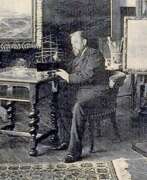

Hans Bohrdt was a German marine painter and graphic artist. Bohrdt's journey into marine painting began after a visit to the Hamburg port at the age of 15, sparking a lifelong passion for the sea and maritime subjects. Unlike many artists of his time who had formal art education, Hans Bohrdt was largely self-taught, although he did attend the Academy of Fine Arts in Berlin for a period. His dissatisfaction with the conventional training led him to pursue a more hands-on approach to his art, focusing on seascapes and marine life.
Hans Bohrdt's work gained significant recognition during the Wilhelmine era, making him a celebrated figure in German marine painting, a genre that became particularly prominent after the unification of Germany in 1871. His close relationship with Kaiser Wilhelm II, who was an admirer and patron of his work, helped elevate Bohrdt's status further. Bohrdt's art was known for its technical skill, particularly in depicting the majesty of the sea and the vessels that traversed it. His pieces often featured German naval prowess and were used for both private collections and public display, contributing to national pride and naval propaganda, especially during World War I.
The legacy of Hans Bohrdt is marked by his ability to capture the spirit and grandeur of maritime life, making him a significant figure in the history of German art. Despite the challenges posed by the world wars, which led to the loss of many of his works including his best-known painting, "Der letzte Mann" ("The Last Man"), Bohrdt's art continues to be celebrated for its contribution to marine painting. In 1995, on the fiftieth anniversary of his death, a memorial exhibition was held, showcasing his contributions to the field and reaffirming his place as one of the last great marine painters.
For collectors and experts in art and antiques, Hans Bohrdt's work offers a unique glimpse into the development of marine painting in Germany, reflecting both the beauty of the maritime world and the historical context of his times. To stay informed about sales, auction events, and updates related to Hans Bohrdt's work, signing up for newsletters from galleries and auction houses specializing in maritime art and antiques is recommended. This ensures enthusiasts and collectors are well-informed about opportunities to acquire pieces by this distinguished artist.
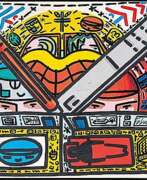

Francois Boisrond is a contemporary French painter. He studied from 1977 to 1980 at the National School of decorative Arts. In 1981 he became involved in the Free Figuration movement. Inspired by visual products (advertising products, posters, stickers, video games etc.), cartoon characters, and by using acrylic paint, Francois Boisrond’s works are colourful, figurative and enigmatic, and his simplified shapes are often outlined in black. He portrays mainly characters, frequently symbolic in everyday situations, but he also depicts urban, maritime or rural landscapes. Besides this Boisrond creates humanitarian and publicity posters. Since the 1990’s the artist has become interested in an imaginary public and the everyday life that invades each and every one of us.
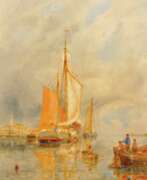

William Joseph Julius Caesar Bond was a British landscape painter.
Influenced by the Pre-Raphaelites in the 1850s, Bond began exhibiting at the Liverpool Academy and was elected associate in 1856 and full member in 1859.
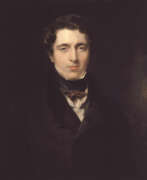

Richard Parkes Bonington was an English Romantic landscape painter, who moved to France at the age of 14 and can also be considered as a French artist, and an intermediary bringing aspects of English style to France. Becoming, after his early death, one of the most influential British artists of his time, the facility of his style was inspired by the old masters, yet was entirely modern in its application. His landscapes were mostly of coastal scenes, with a low horizon and large sky, showing a brilliant handling of light and atmosphere. He also painted small historical cabinet paintings in a freely-handled version of the troubadour style.
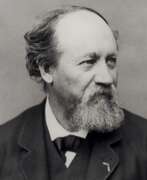

Eugène Louis Boudin was one of the first French landscape painters to paint outdoors. Boudin was a marine painter, and expert in the rendering of all that goes upon the sea and along its shores. His pastels, summary and economic, garnered the splendid eulogy of Baudelaire; and Corot called him the «King of the skies».
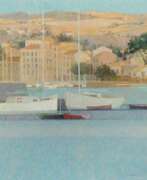

André Bourrié, full name André Georges Jules Louis Bourrié, was a French painter.
He was known for his city and seascapes, which used oil paint, sometimes mixed with chalk and sand to create a textural effect on the canvas.
Bourrier's work has been exhibited in galleries and museums around the world, including the Centre Pompidou in Paris and the Galleria Bohemia in New York.
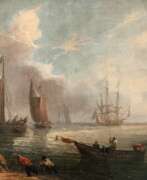

Pieter Bout was a Flemish painter, draughtsman and etcher. He is known mainly for his landscapes, city, coast and country views and architectural scenes painted in a style reminiscent of earlier Flemish masters such as Jan Brueghel the Elder.
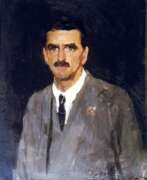

Theodore Penleigh Boyd was a British born Australian artist. Penleigh Boyd was a member of the Boyd artistic dynasty: his parents Arthur Merric Boyd and Emma Minnie Boyd (née à Beckett) were well-known artists of the day, and his brothers included the ceramicist Merric Boyd and the novelist Martin Boyd. Penleigh Boyd is best known as a landscapist with an accomplished handling of evanescent effects of light. A notable influence was artist E. Phillips Fox, who introduced him to plein air techniques when they were neighbours in Paris.
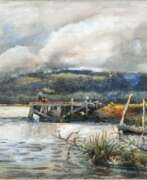

Arthur Merric Boyd was an Australian painter. He and his wife Emma Minnie (née à Beckett) established a lifestyle of being artists which many generations followed to create the popular image of the Boyd family. Boyd travelled and painted a good deal on the continent of Europe, and returned to Australia about the end of 1893, where he lived mostly in Sandringham and other suburbs of Melbourne for the rest of his life. He occasionally sent good work to the exhibitions of the Victorian Artists' Society, but never mixed much in the artistic life of his time.
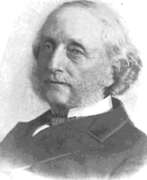

William Bradford was an American romanticist painter, photographer and explorer, originally from Fairhaven, Massachusetts, near New Bedford. His early work focused on portraits of the many ships in New Bedford Harbor. In 1858, his painting New Bedford Harbor at Sunset was included in Albert Bierstadt's landmark New Bedford Art Exhibition.
He is known for his paintings of ships and Arctic seascapes. He was one of the first American painters to portray the frozen regions of the north.
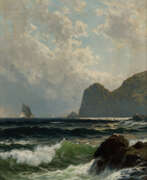

Alfred Thompson Bricher was a painter associated with White Mountain art and the Hudson River School.
In the 1870s, he primarily did maritime themed paintings, with attention to watercolor paintings of landscape, marine, and coastwise scenery. He often spent summers in Grand Manan, where he produced such notable works as Morning at Grand Manan (1878). In 1879, Bricher was elected into the National Academy of Design as an Associate member.
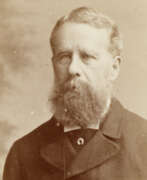

Sir Oswald Walters Brierly was a British traveler, soldier and marine artist.
Brierly studied painting and naval architecture, rigging in depth; comprehending the intricacies of navigation, he traveled to Australia. There he became acquainted with whaling and created several paintings on the subject.
In 1850, at the invitation of Admiral of the British Royal Navy Sir Henry Keppel on his ship crossed the Pacific Ocean, circled South America and returned to England. Keppel's account of the voyage, published in 1853, included eight lithographs by Brierly, who on his return became a Fellow of the Royal Geographical Society.
In the Crimean War, Sir Oswald Brierly also served with Henry Keppel as an artist-observer on the warship HMS St Jean d'Acre, part of the Allied Baltic Fleet. The artist accompanied the royal family on a trip to Egypt in 1869. Brierly made many more voyages and created many watercolors on subjects related to the sea and ships.
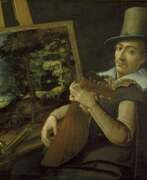

Paul Bril was a prominent Flemish painter, best known for his significant contributions to landscape painting. Born around 1554 in Antwerp, he later moved to Rome, where he became a central figure in the art scene, influencing the Italian and Northern European landscape painting traditions.
Paul Bril's early works were steeped in the Flemish manner, exhibiting a picturesque arrangement of landscape elements with dramatic contrasts of light and dark. His style evolved during his stay in Rome, influenced by the work of Annibale Carracci and Adam Elsheimer. By around 1605, Bril's compositions became more serene and classical, showcasing calmer transitions from foreground to background and embracing pastoral and mythological themes.
Paul Bril's contributions extended beyond his paintings. He was a respected figure in Rome's art community, becoming the first foreign director of the Accademia di San Luca in 1621. His patrons included some of the most influential families in Rome, and his work was sought after by collectors and fellow artists. Bril's influence was profound, impacting future generations of artists, including the Dutch Italianates and genre painters active in Rome.
His works can be found in prestigious galleries worldwide, illustrating his enduring legacy in the art world. For collectors and art and antiques experts, Paul Bril's work represents a significant period in the evolution of landscape painting, blending Flemish traditions with Italian classicism.
For those interested in exploring the captivating landscapes and historical significance of Paul Bril's art, staying informed about new product sales and auction events is essential. Signing up for updates can provide valuable insights and opportunities to acquire pieces associated with this influential artist.
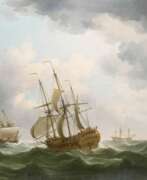

Charles Brooking is a British marine artist.
He is known for his paintings depicting various ships at sea. Researchers have noted great accuracy in depicting structures and ocean waves and wind, which may indicate that Brooking had experience at sea.
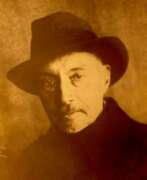

Nikolai Evlampievich Bublikov (Russian: Николай Евлампиевич Бубликов) was a Russian and Soviet artist of the late 19th and first half of the 20th centuries. He is known as a marine and landscape painter, a representative of the Leningrad school of painting.
Nikolai Bublikov was distinguished by the use of a wide spatial perspective and a subtle range of colors in his works. He is considered the first artist who in his work raised the theme of the Soviet Navy. During the Great Patriotic War, the artist stayed in Leningrad and died during the siege of the city.
His works can be found in various museums and private collections in Russia and abroad, including the Russian Museum and the Central Naval Museum in St. Petersburg.
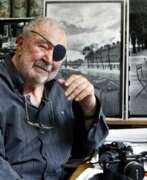

Lothar-Günther Buchheim was a German writer, artist, and collector.
He studied at the Academy of Fine Arts in Dresden and at the Academy of Fine Arts in Munich. During World War II he served in Hitler's navy as a correspondent and worked as a war artist for the Nazi propaganda apparatus. His portraits of Third Reich officers and images of submarines were successful. Buchheim rose to fame with his novel Das Boot, which became an international bestseller and the basis for the movie Submarine.
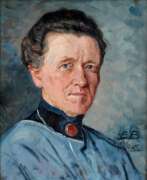

Elisabeth Büchsel, full name Elisabeth Charlotte Helene Emilie Büchsel, was a German artist. She studied painting in Berlin, Dresden, Paris and Munich.
Elisabeth Büchsel painted mainly portraits and landscapes of Rügen and Stralsund. From 1904 she lived and worked on the island of Hiddensee from spring to autumn.
Büchsel was a member of the Association of Visual Artists of Germany.
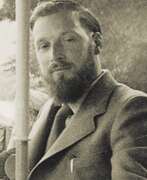

Lionel Victor Bulmer was an English impressionist painter, a member of the New English Art Club, founded in 1886 as an exhibition society dedicated to promoting the avant-garde technique of French impressionist painting, the influence of which was clearly evident in Bulmer's own work.
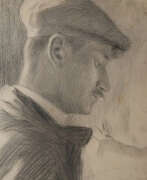

Georg Burmester was a German artist of the late 19th - first third of the 20th centuries. He is known as a painter, graphic artist, impressionist, representative of the Düsseldorf art school, and teacher.
Burmester worked mainly in the genres of landscape and marinas, but among his works there are also still lifes, as well as works in the genre of nude. He was a teacher at the Kassel Art School from 1912 to 1930 and was promoted to the rank of professor in 1917.
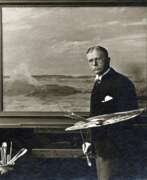

Howard Russell Butler was an American artist renowned for his multifaceted contributions to art and culture, particularly in painting and architecture. Howard Russell Butler's journey in art began after an illustrious education in science at Princeton University, leading him to merge his scientific acumen with artistic prowess. His specializations in landscape and portrait painting gained significant acclaim, but it was his unique ability to capture solar eclipses and celestial phenomena that distinguished his work, earning him a place in the annals of art history.
Howard Russell Butler's legacy includes the accurate portrayal of the 1918 solar eclipse, an event that marked a significant milestone in his career. He was invited by the U.S. Naval Observatory to document this celestial event, utilizing his skills to capture nuances that photography of the time could not. His works on solar eclipses are celebrated for their precision and beauty, providing invaluable insights into a fleeting natural phenomenon.
Aside from his celestial paintings, Howard Russell Butler's contributions to American landscapes are noteworthy. His paintings of Zion National Park and the Grand Canyon, commissioned by the Union Pacific Railroad, played a pivotal role in promoting tourism to these iconic locations. These works, now housed in national parks and museums, reflect Butler's deep appreciation for America's natural beauty and his skill in conveying it through his art.
Howard Russell Butler's works are preserved in prestigious institutions like the Metropolitan Museum of Art, the Smithsonian American Art Museum, and the American Museum of Natural History, where audiences can witness the breadth of his talent and the depth of his contributions to art and science. His ability to blend scientific precision with artistic expression left an indelible mark on the art world, making his works cherished pieces of American cultural heritage.
For collectors and art and antiques experts, Howard Russell Butler's oeuvre offers a unique intersection of art, science, and history, presenting opportunities to explore the rich narratives behind his creations. Whether it's the dynamic portrayal of natural landscapes or the meticulous depiction of celestial events, Butler's art continues to inspire and captivate audiences.
If you're keen on staying updated with sales and auction events related to Howard Russell Butler's works, consider signing up for updates. This subscription will ensure you're informed about new opportunities to engage with the art and legacy of this remarkable artist, without any undue pomp or extravagance.
